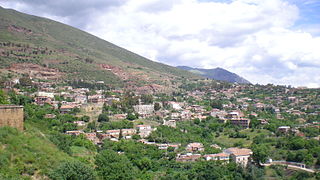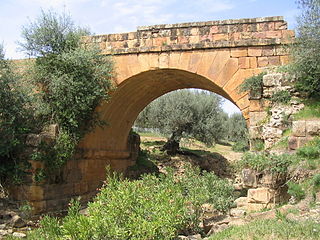
Tubusuctu [1] also known as Colonia Iulia Augusta Legionis VII, was a Roman colony [2] founded by Augustus for military veterans and known for its olive oil. [3] [4] [5]

Tubusuctu [1] also known as Colonia Iulia Augusta Legionis VII, was a Roman colony [2] founded by Augustus for military veterans and known for its olive oil. [3] [4] [5]
The town is located at 36.667565, 4.8462225 near El Ksour, Algeria and flourished from 330 BC - AD 640. [6] [7]
The town lies in a valley on the left bank of the Soummam, occupying an eminence and the plain running along it on S and E, where there are still vestiges of ramparts. The ruins have suffered from the cultivation of the region. To the S of the eminence are important baths, 50 m square in plan. To the N, in the center of the ruins, and to the E are the remains of immense cisterns. The N cisterns, fed by an aqueduct coming from the W, measure 35.5 x 77 m and are made up of 15 connected basins; the vaults were semicircular in section and there were interior and exterior buttresses. The ruins of the E cistern, fed by an aqueduct [8] leading from the S, crossing the river via a bridge now gone, are confused and disjointed. Not all the important waterworks appear to be contemporary; it seems that the military importance of the site, in a region where there were numerous revolts in the 3d and 4th c., justified these creations. [9]
Tubusuptu, located in the fertile Soummam River valley just south of the Port of Saldae, was populated by the Roman soldiers [10] of the Legio VII Claudia. The Roman veterans of Legion VII merged into the population of the valley of the Soummam River.
The region's olive oil was very popular and Tiklat jars were found throughout the Roman Empire, [11] which proves its commercial importance at the beginning of the Christian era. [12] [13] [14]
Today there are still vestiges. There is an aqueduct and also well-preserved thermal baths. [12] An almost intact mosaic is also present on site.
The archaeological district of Béjaïa is planning to carry out work to preserve the site and prevent its degradation. The French archaeologist Jean-Pierre Laporte made a study of these ruins in the 1960s. [15] [16] [10]
Several inscription survive in the ruins. [17]
The town is attested in Pliny; [18] Ptolemy [19] and Ammianus Marcellinus [20] The town also appears in the Ravenna Geographer, and Julius Honorius [21] but it is missing from the Antonine Itinerary. [9]
In the late Roman period it became the centre of a military district. [22]
The town was a center for early Christianity with bishops for the town being recorded in 411 and in 484. [9]
The bishopric survives today as a titular see of the Roman Catholic Church and the current bishop is Alphonse Marie van den Bosch. [23]

Lambaesis (Lambæsis), Lambaisis or Lambaesa, is a Roman archaeological site in Algeria, 11 km (7 mi) southeast of Batna and 27 km (17 mi) west of Timgad, located next to the modern village of Tazoult. The former bishopric is also a Latin Catholic titular bishopric.

Saldae was an important port city in the ancient Roman Empire, located at today's Béjaïa. It was generally a crossroads between eastern and western segments of Northern Africa, from the time of Carthage to the end of the Byzantine Empire from the continent.

Miliana is a commune in Aïn Defla Province in northwestern Algeria. It is the administrative center of the daïra, or district, of the same name. It is approximately 114 kilometres (71 mi) southwest of the Algerian capital, Algiers. The population was estimated at 44,201 in 2008. The town is located south of the Dahra Range, on the wooded southern flank of Mount Zaccar Rherbi, five kilometers north of the Chelif River, and overlooking the Zaccar plateau to the west.

Cremna, or Kremna, was an ancient town in Pisidia. It is situated in the district of Bucak. It stands in a remote valley on a high plateau dominating the ancient Cestrus River, with limited access and good defensive features.

Khamissa, ancient Thubursicum Numidarum or Thubursicum, is an Ancient Roman and Byzantine archeological site, in Souk Ahras Province of northeastern Algeria.

Thuburnica was an ancient Roman-Berber city in the Maghreb. It was located in the present-day El Kalâa, near Chemtou in western Tunisia. It may have been the ancient town of Bulla Regia.

Akbou or Aqvu is a town in the Kabylie region in northern Algeria in Béjaïa Province. It is a growing city with a population of 52,300 in 2008. This is a number approximately 20,000 more than what was recorded in 1998.

El Kseur is a town in northern Algeria.

Aquincum was an ancient city, situated on the northeastern borders of the province of Pannonia within the Roman Empire. The ruins of the city can be found today in Budapest, the capital city of Hungary. It is believed that Marcus Aurelius wrote at least part of his book Meditations at Aquincum.

Uzinaza is an ancient Roman-Berber city located in present-day Algeria. It is located in the modern commune of Saneg.

Cartennae or Cartenna was an ancient Berber, Carthaginian, and Roman port at present-day Ténès, Algeria. Under the Romans, it was part of the province of Mauretania Caesariensis.

Abbir Maius also known as Abbiritanus was a Roman and Byzantine-era civitas (city) in the Roman province of Africa proconsularis.

Vicus Maracitanus was a civitas of the Roman Province of Roman North Africa that has been identified with ruins at 36° 01′ 04″ N, 9° 13′ 47″ E the modern village of Ksar-Toual-Zouameul in Siliana province Tunisia.
Toukabeur is a town in Béja Governorate, Tunisia located at 36°42′32″N, 9°31′16″E. Toukabeur is in the Medjerda River valley, and 2 km west of Chaouach (Suas) and 7 kilometers northwest of Majaz al Bab,(Membressa). Its postal code is 9024.

Iomnium was a Phoenician, Carthaginian, and Roman port on Algeria's Mediterranean coast at the site of present-day Tigzirt.

Gunugus or Gunugu was a Berber and Carthaginian town in northwest Africa in antiquity. It passed into Roman control during the Punic Wars and was the site of a colony of veteran soldiers. It survived the Vandals and Byzantines but was destroyed during the Muslim invasion of the area.

The Soummam River is a river in northern Algeria, born from the confluence of the Oued Sahel and the Oued Bou Sellam near Akbou and flowing into the Mediterranean Sea at Béjaïa.

Temuniana was a Roman town of Roman North Africa which existed during the Vandal Kingdom, Byzantine Empire and Roman Empire.

Marazanae was a Roman town of the Roman province of Byzacena during the Roman Empire and into late antiquity.
The Kalâa of the Aït Abbas or Kalâa of the Beni Abbes, sometimes spelled Qal'a or Guelaa, was a citadel and the capital of the kingdom of Ait Abbas, which was founded in the sixteenth century in the Bibans and almost totally destroyed during the revolt of Cheikh Mokrani in 1871.